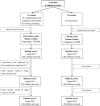Effectiveness of complementary food supplements and dietary counselling on anaemia and stunting in children aged 6-23 months in poor areas of Qinghai Province, China: a controlled interventional study
- PMID: 27799239
- PMCID: PMC5093399
- DOI: 10.1136/bmjopen-2016-011234
Effectiveness of complementary food supplements and dietary counselling on anaemia and stunting in children aged 6-23 months in poor areas of Qinghai Province, China: a controlled interventional study
Abstract
Objective: To assess the effectiveness of dietary counselling and complementary food supplements on anaemia and stunting prevalence in children aged 6-23 months.
Design: A controlled intervention study with measurements of height and haemoglobin levels, and cross-sectional surveys in August 2012 (baseline), 2013 (mid-term) and 2014 (end-line).
Setting: One intervention county and one control county in rural Qinghai Province, China.
Intervention: Complementary food supplements (containing protein, fat, carbohydrate, vitamin A, B1, B2, B12, D3, folic acid, iron, zinc and calcium) and complementary feeding counselling were given in the intervention county.
Participants: Caregivers and their children aged 6-23 months.
Primary and secondary outcome measures: Effect of the interventions on the prevalence of anaemia (haemoglobin <110 g/L) and stunting (z-score of height-for-age <-2.0) (controlled for differences between the counties), and on infant feeding practices.
Results: The surveys were conducted on 1804, 2187 and 2186 children aged 6-23 months in the intervention county in August 2012, 2013 and 2014, respectively, and 804, 680 and 790 children in the control county, respectively. Between the baseline and end-line surveys, anaemia prevalence decreased more in the intervention county than in the control county (71.1% to 47.8% vs 86.3% to 75.3%, respectively; p<0.0001). There was no difference in the decrease in stunting prevalence between the counties (9.7% to 7.1% vs 17.0% to 15.0%; p=0.7954). The proportions of children given iron-rich or iron-fortified food, introduced to (semi-) solid food at 6-8 months, and given food with minimum dietary diversity increased from 43.2% to 88.8% (p<0.0001), 81.4% to 96% (p=0.0470) and 53.0% to 59.8% (p<0.0001), respectively in the intervention county.
Conclusions: We found much higher anaemia prevalence in poor rural areas of Qinghai Province compared with the national data. Community-based complementary food supplements combined with dietary counselling can improve feeding practices and reduce anaemia prevalence. Future studies should use longer follow-up to assess the effects on stunting.
Strengths and limitations: We included a large number of participants and assessed a combined complementary food supplements and dietary counselling intervention in a poor rural area in China with high anaemia prevalence. Although the study took place in only one intervention county and one control county, we conducted an analysis that controlled for differences between the two counties. Also, although we made significant efforts to train village doctors, their education was not systematically assessed after training and thus their delivery of the interventions may have been variable.
Trial registration number: ChiCTRPRC12002444; Pre-results.
Keywords: China; Undernutrition; anemia; complementary food supplements; dietary counseling.
Published by the BMJ Publishing Group Limited. For permission to use (where not already granted under a licence) please go to http://www.bmj.com/company/products-services/rights-and-licensing/.
Conflict of interest statement
Conflicts of Interest: None declared.
Figures


References
-
- Ministry of Health China. National report on nutritional status of children aged 0–6 year (2012). Beijing, 2012.
-
- Michael S, Kramer RK. The optimal duration of exclusive breastfeeding: a systematic review. World Health Organization, 2001.
-
- PAHO. Guiding principles for complementary feeding of the breastfed child. 2003.
-
- Chunming C. Fat intake and nutritional status of children in China. Am J Clin Nutr 2000;72:1368S–72S. - PubMed
-
- Yi C, Fang G, Zhang F. Survey of status of complementary food in Li ethnic infants in rural areas of Hainan Province. Zhong Guo Re Dai Yi Xue 2007;7:638–9.
Publication types
MeSH terms
Substances
Associated data
LinkOut - more resources
Full Text Sources
Other Literature Sources
Medical
